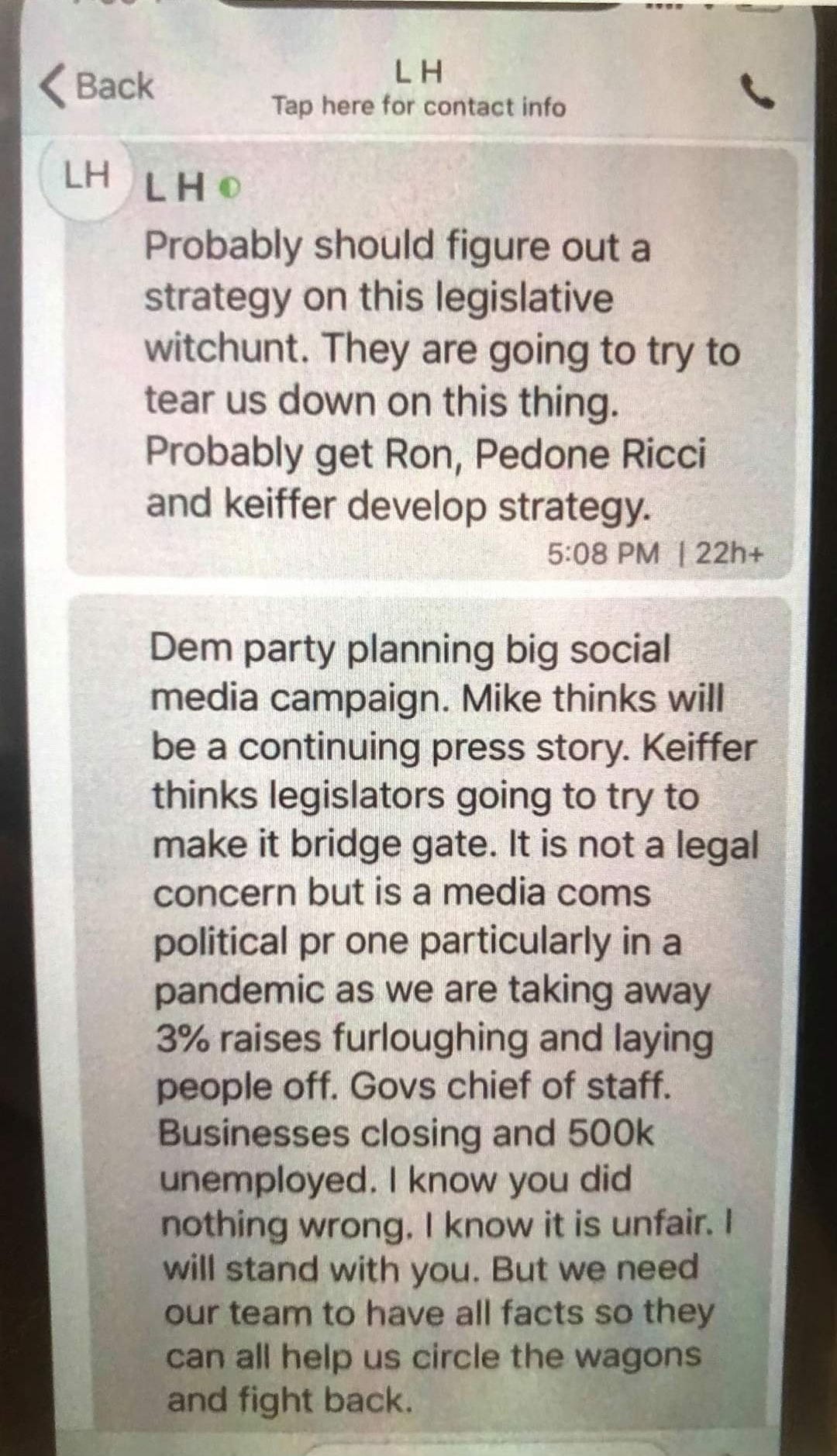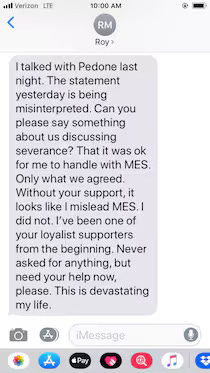Larry Hogan’s Dead Chief of Staff
Before dying in a police shootout, Roy McGrath called for an investigation into Gov. Hogan’s Korean covid test scandal
Published at Counterpunch
The coroner couldn’t say whether it was Roy McGrath or the FBI who fired the fatal shot, but after two to the head McGrath was dead at 53. Publicly, Larry Hogan said all the right things in the wake of the death of his former chief of staff; thoughts and prayers for the family, etc. But privately Hogan, the former Republican governor of Maryland now running for Senate, must have breathed a sigh of relief. He no longer had to worry about his longtime friend running his mouth, or releasing secret recordings.
McGrath at the time of his death last year faced charges for secretly recording Hogan and other top state officials. But it was another case, regarding his pilfering from the state agency he led before becoming chief of staff, that had McGrath set to appear in a federal courtroom in Baltimore last March. Only he never showed; he was now a fugitive.
Two weeks before things ended tragically – with McGrath shot in the head in a Costco parking lot outside Knoxville, Tennessee, his car boxed in by police – McGrath’s journey took another unexpected turn. As he evaded capture while traversing the southeastern US, McGrath became something of a literary star when he self-published a short e-book that rocketed to number four on Amazon’s “Political Commentary & Opinion” list. The book (below), written in the third person and under the pseudonym Ryan Cooper, offers a peek into Hogan’s inner sanctum at a time when two scandals were erupting. (McGrath published a second e-book four days before his death; a promised third book never materialized.)
The first scandal: covid tests
At the height of the pandemic Gov. Hogan was fixated… on becoming president. Appearing heroic in this hour of need was essential, so Hogan devised an audacious PR stunt.
Rather than purchase US covid tests, readily available at the time, Hogan paid an eye-popping $9.5 million for 500,000 tests from South Korea. They had to be from South Korea so Hogan could cast his wife as Robin to his Batman, his sidekick who saved Marylanders’ lives by negotiating with her home country.
“Marylanders already knew and loved her as their gracious and caring first lady. But they didn’t know about her international diplomacy skills or her tenacity,” Hogan wrote in his memoir, Still Standing. On a March 2020 call with the South Korean ambassador, “Yumi made a personal plea in Korean, asking for the nation’s help. That request set in motion what we called Operation Enduring Friendship.” (Hogan lifted his dramatic branding from, of all things, George W. Bush’s failed “Operation Enduring Freedom” in Afghanistan.)
By buying abroad, Hogan was able to create another self-serving storyline: how he’d gone behind President Trump’s back to save lives. “Truly, the story was larger than politics,” Hogan wrote. “It cut across every line. The governor who’d grown tired of waiting went out and found his own tests.” (Yes, those are Hogan’s own italics.)
“It took dozens and dozens of phone calls, night after night – sometimes it seemed like all night – working through language barriers and a thirteen-hour time difference… No one knew how many lives those 500,000 tests might save, but it would be a lot.”
Meanwhile, Hogan’s tests didn’t actually work. Rather than own up to this, Hogan’s administration “quietly paid” $2.5 million for an additional 500,000 tests from the same company, LabGenomics, reported top-notch Washington Post investigative journalist Steve Thompson. This pushed the overall cost to $24 per test, more than twice as much as US tests offered to Hogan’s team at the time. Still Hogan claimed, “It was quite a bargain, actually.”
Bargain or not, Hogan’s new tests were also faulty. They gave false positives, roiling Maryland’s senior centers and state universities that used them (at Hogan’s urging). Hogan’s scheme was now endangering lives, not just wasting money. “Hogan had knowingly put the lives of Marylanders at risk, just to avoid public embarrassment,” McGrath wrote in Betrayed: The True Story of Roy McGrath. “His deceit makes Maryland’s disgraced, former governor, Spiro T. Agnew, look like a boy scout.”
Hogan, never one to let facts get in the way, stuck to the script. There hadn’t been “a single problem with one single LabGenomics test kit,” he said. The Baltimore Sun, in staggered disbelief at Hogan’s dishonesty, wrote in response, “Not. A. Single. Problem.”
Hogan squandered further precious time and money by insisting that state labs, already besieged by the pandemic, prioritize processing his tests. “Hogan was determined to use up the thousands of faulty tests,” McGrath wrote.
“So, he directed his team to work with the [University of Maryland at Baltimore]1, whom he had financial influence over, to use them up in their lab. Of course, they had the same bad results. Was it time for Hogan to come clean? Nope. Hogan instead directed the building of a new lab specifically for the purpose of using up the kits. More state taxpayer dollars down the Korean drain.”
To turn the University of Maryland at Baltimore’s lab into “the backbone of the state’s testing strategy,” Hogan’s administration provided $2.5 million. But after a slew of suspected false positives, the lab abruptly dropped Hogan’s tests, the Post’s Thompson reported.
Having hit another wall, Hogan’s team turned to the state’s public health lab, whose director agreed to process Hogan’s tests despite his “serious concerns.” Yet just six weeks later Hogan’s team changed course again, pulling the tests from the public lab in favor of a private one.
Here at last Hogan found a willing dance partner. The private lab — CIAN Diagnostics of Frederick, Maryland — not only processed Hogan’s tests, but praised them for their “robustness and stability.” Meanwhile CIAN’s initial April 2020 contract with the state, worth as much as $3.9 million, ballooned to as much as $45 million four months later.
God only knows how many tens of millions of tax dollars Hogan squandered, first enacting his PR stunt, then covering up its failures. It’s also unclear how many deaths he caused.
The time wasted buying faulty tests “delayed the procurement of more reliable tests, which in turn impeded Maryland’s efforts to control the pandemic,” David Plymyer, former Anne Arundel County Attorney, wrote at Maryland Matters.
“[Hogan’s tests] also posed more direct dangers. A spate of false positives at nursing homes resulted in COVID-free patients being moved to areas of the facilities where patients with COVID were isolated, needlessly exposing healthy residents to residents with the disease.”
It was around this time that our protagonist, Roy McGrath, started making recordings. “Roy had begun recording select conversations in order to protect himself from what he saw as a looming scandal,” McGrath wrote, using the third person. Blissfully unaware of McGrath’s misgivings, Hogan promoted him to chief of staff (his fourth in five years). It would prove a fateful appointment.
The second scandal: a golden parachute
The state agency McGrath helmed before becoming Hogan’s chief of staff, the Maryland Environmental Service (MES), was almost entirely publicly funded, with only five percent of its $160 million budget coming from private sources. Yet McGrath fancied himself a “CEO,” and he spent like one. On the taxpayers’ dime he traveled the country and world, all while earning a $233,000 salary, plus a “customary” 15 percent bonus that netted him an extra $35,000 annually. “It’s a cushy gig as these things go,” McGrath texted his successor on the way out the door.
Having breathed such rarified air for three-and-a-half years, McGrath hesitated to take the chief of staff position, where he’d earn the same $233,000 salary but without the bonuses and perks he’d grown accustomed to. Still, McGrath was willing to make the move as long he received a year’s pay as severance. (McGrath also requested $55,000 in questionable last-minute reimbursements, bringing his parting gift to nearly $300,000.)
The MES board had to approve McGrath’s payout, and it did, but only after McGrath told them Hogan had ok’d it. When Hogan was later asked about this, however, he said he’d done no such thing. And McGrath wound up charged with, among other things, fraudulently obtaining his severance.
But before all this came to light, and no one was the wiser, McGrath’s transition to chief of staff was going smoothly. It was only when the Baltimore Sun caught wind of the payout that everything changed in an instant and all hell broke loose.
With a growing scandal on his hands, Hogan initially stood by his chief of staff. Via Wickr — a self-destructing messaging system Hogan used to communicate with top aides — Hogan texted McGrath (who took a picture of the text before it was destroyed):
“It is not a legal concern but is a media coms political pr one particularly in a pandemic as we are taking away 3% raises furloughing and laying people off… Businesses closing and 500k unemployed. I know you did nothing wrong. I know it is unfair. I will stand with you.”

Fearing Democrats would go on a “legislative witchunt” and “try to tear us down on this thing,” the team needed to “circle the wagons and fight back,” Hogan wrote. But as the fallout intensified, McGrath found himself outside the circle, with Hogan not responding to him, despite their decades-long friendship. (The two met in 1992 when McGrath, then a student at the University of Maryland, worked on Hogan’s unsuccessful campaign for Congress.)
“I’ve been one of your loyalist supporters from the beginning. Never asked for anything, but need your help now, please. This is devastating my life,” McGrath texted Hogan. There would be no response. After just eleven weeks on the job, McGrath was forced to resign in disgrace. (Hogan claimed he was “terminated.”) It had been just four days since the Sun story broke.

‘Under oath’
In the ensuing three years, McGrath tried to move on with his life. He sold his Maryland home, relocated to Florida, and married his girlfriend. A fresh start and sunshine, however, couldn’t rid McGrath of his legal troubles, which only worsened.
While McGrath may be most remembered for his dramatic demise, something else stands out for me. In his final days, McGrath single-handedly did what our media has not: expose Larry Hogan for who he really is. (Two other Maryland officials also tried to do so and lost their jobs.)
Before Hogan barrels his way into the Senate, as early polls indicate he may, further investigation of his test scandal is warranted. As McGrath pleaded, “Put the people involved under oath, and get to the disturbing truth about Hogan’s deranged actions.”
McGrath actually wrote “University of Baltimore,” but I believe he meant University of Maryland at Baltimore, which is a common mix-up.








riveting article. We need this kind of "Walter Cronkite", just the facts type investigative journalism. Pete you rock man